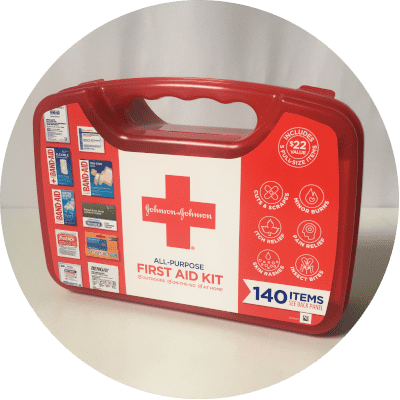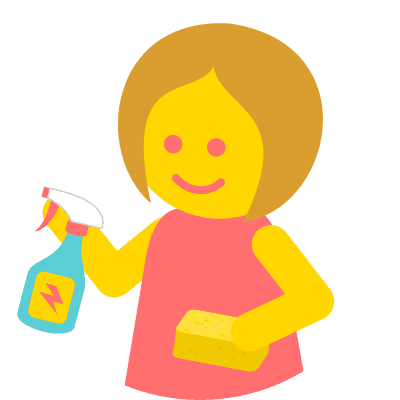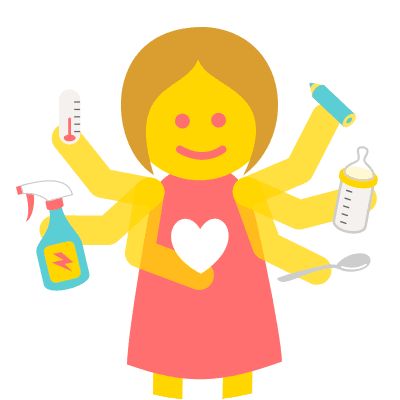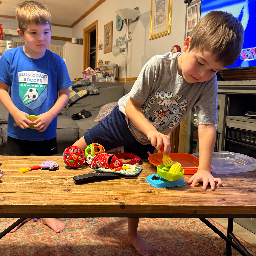21 Babysitting Bath Time Tips (Safety Guide, Checklist, Video)


Written & Illustrated by
Matthew James Taylor
Kidsit Founder, General Manager

Bathtime video by
Lydia Kutz
Babysitter, Infant Swimming Resources Instructor

Medically Reviewed by
Gina Maria Jansheski, MD, FAAP
Board-Certified Pediatrician, Medical Reviewer
Key Takeaways
- Never leave a child unattended in the bath - even a momentary lapse in supervision can be dangerous.
- Always ask parents first - don’t assume giving a bath is part of your job unless it’s cleared in advance.
- Prepare everything in advance - have towels, soap, toys, clothes, etc., ready and within reach so you never have to leave the child alone.
- Check water temperature carefully - aim for a lukewarm bath, test with your forearm or elbow, and keep an eye on cooling water mid-bath.
- Keep bath times short, especially for young kids - about 10–15 minutes is usually sufficient to avoid skin dryness and fatigue.
- Make bath time fun yet safe - use bath toys, gentle soaps, and engaging routines while maintaining vigilance.
Bath time can be intimidating for babysitters, and with good reason! Keeping a close eye on children during bath time is essential since kids can start to drown within seconds. Bathing a child is also one of those vulnerable situations that could predispose to accusations of misconduct if not handled correctly.
What are our best babysitting bath time tips: Always provide constant supervision during bath time and get everything within arm’s reach beforehand, so you don't need to move. Ensure the temperature is not too hot or cold, use kid-friendly soaps and shampoos, and try some bath time activities to make washing fun. Always fully empty the bath when you're done.
Kidsit babysitting statistics
45.67% of babysitters are comfortable bathing kids, 48.59% are fine with changing diapers, and 27.33% can assist with toilet training.
(Babysitting statistics calculated weekly from our live member data — Updated 21 Dec 2025)
In this article, you'll learn how to keep infants and young children safe during their bath and how to make bath time fun for them. If you've never given a child a bath before, it might be one of the more intimidating tasks you'll face as a babysitter. It's definitely up there with things like changing a diaper for the first time (see our diaper guide for help with that). But after you've finished reading through the tips below, you should be ready to handle giving baths as a babysitter.
Lydia has been working in the childcare industry for 15 years, and owned a childcare agency in Florida, USA for 7 years. In this video she explains what to do to make bath time run smoothly and reliably for you and the kids.
Should Babysitters Bathe Children?
Babysitters should confirm with parents 100% of the time before they bathe their children. A couple of decades ago, it might not have been such a big deal. But now, with people of all professions in the news being accused of inappropriate behavior, it's important to know the appropriate methods for babysitters to manage this very common task.
Never just assume that a family will want you to give their child a bath as part of your babysitting duties.
Ultimately, whether you need to bathe a child or not while you're babysitting will come down to what the family needs and wants, as well as what you as the babysitter are willing to do! Some babysitters will refuse to give kids they're watching a bath, either just because they don't feel comfortable with it, or to avoid potential liability. Their concern very often depends upon the ages of the children, as well.
Generally, if you're a teenage babysitter just watching a child for the occasional date night, you're a lot less likely to need to give kids a bath. Infants and very young children don't necessarily require a bath every single day anyway, as it can dry out their skin and lead to other problems.
However, if you're a regular babysitter who watches children for a family every day, or at least on a regular basis, you're more likely to end up needing to bathe the kids.
Like a lot of areas of babysitting, bath time really comes down to proper communication with parents to find out what's needed, how it should be done, and what you're both comfortable with.
What other kinds of things should you talk to parents about first? Learn more here - What Should Babysitters Ask Parents? (20 Important Questions)
1. Provide Constant Supervision
By far, the most important part of keeping kids safe during bath time is proper supervision.
Never, ever leave kids alone in the bathtub (or shower). It just takes a few seconds for a toddler or baby to slip below the surface of the water and start drowning.
When it's time to give a child a bath, make sure there are no distractions. Put your cell phone on vibrate and keep it with you in case the parents call or you need it for an emergency. Finish up any other tasks you're doing so you can give the bath your undivided attention.
If for some reason you need to leave the bathroom, you'll need to wrap the child in a towel and take them with you. Don't just take them out of the tub and leave them in the bathroom, as they could climb and fall back into the tub while you're gone.
2. Learn Infant CPR
Even if you're paying close attention and know what you're doing, accidents still sometimes happen. So it's a good idea to take a course in infant CPR if you're going to be babysitting little ones.
Infants are a lot more fragile than teens or full-grown adults, and their bodies work differently, so you definitely can't just transfer over your regular CPR training. Special resuscitation procedures are designed to help if a baby becomes unconscious, stops breathing, or doesn't have a pulse.
See my recommended babysitting courses.
3. Keep Bath Time Short (Especially for Toddlers and Infants)
For toddlers or infants, bath time should be short and sweet. If their skin is starting to get wrinkly, they've definitely been in too long!
Try to keep baths for younger kids under 10 or 15 minutes at most. That way, kids are less likely to get dry skin.
4. Get Everything Ready Ahead of Time
So when starting bath time I collect everything I need and I usually encourage the kids to help me with this, so they can collect 4 bath toys, their towel, their pyjamas, I make sure I have my phone with me in case of an emergency. So we gather our supplies for the bath before even getting in.

Babysitter, Infant Swimming Resources Instructor
St Petersburg, Florida, United States
Make things much easier on yourself by gathering up everything you'll need ahead of time, like a couple of towels, soap, shampoo, a washcloth, lotion, a change of clothes, toys, and a diaper.
Having everything within arm's reach means you'll be able to be right next to the child you're bathing at all times, without having to leave them alone while you jump up to get supplies. Run the scenario of bathing through your head first, to make sure you have everything that you need right there next to the tub.
After you've bathed the kids and put them to bed, can you have a bit of a nap yourself? Read my other article to find out - Can Babysitters Sleep On the Job? (6 Tips to Stay Awake)
5. Check the Water Temperature Before Putting Kids in the Tub
When you're running the bath you want to make sure that it's not too hot, not too cold, so what I do is I run my elbow under the faucet to guage how hot or cold it is. You want it a little above room temperature so it's nice getting in.
While the bath is filling up, and I usually only fill it up to the kids belly button, when they're seated, so depending on how big they are, how small they are, how old they are depends on how much I fill the bath.

Babysitter, Infant Swimming Resources Instructor
St Petersburg, Florida, United States
Never just place a child into bathwater without checking the temperature first.
Always start by filling a bath with lukewarm water, then slowly add warmer water to it until it reaches the right temperature (by testing with the inner side of your forearm). Then finish with just a short burst of cold water. That way, the tap will be physically cool to the touch.
If you have a thermometer, you can check that the water is between 37 and 38 degrees C (98.6 to 100.4 degrees F). That's a comfortably warm temperature that won't risk scalding or chilling them. Parents might also have special decals, bath mats, or floaties that change color when water is too hot for children, but you should not rely entirely on them to check for the correct temperature for an infant or very young child.
Most of the time, you probably won't have access to a thermometer or other specialized tools to check the bath temperature while you're babysitting. In any case, you should always make sure the water is warm but not too hot by dipping your elbow way down into the water. Don’t just test the top layer as it cools faster, and there is still the potential to burn a little one when placing them into the tub.
While not making the bathwater too hot is a big concern when you're first putting a child into it, letting the water get too cold can be bad for kids too. You'll want to keep reassessing the temperature of the water as you're bathing a child. If the water starts to feel cool, it's time to end the bath.
If you still have a lot of washing up to do and want to make the water warmer again, it's best to take the child out of the bath while you do it. It's dangerous to add hot water into the tub while the little one is in there. You risk making the water too warm or having hot water straight from the tap make contact with their skin before it has a chance to mix with the rest of the water and cool down.
6. Wash Kids From Head to Toe
I usually give the kids two choices, either we wash and then we play or we play and then we wash and if they choose to play before we wash then I'll give them an amount of time and set it on my phone, when the timer goes off then we soap up and wash down. If they're younger and they can't really choose, I choose for them, we wash and then we play. That way if they don't like the bath the bad part is over with and they can just have fun playing in the bath.

Babysitter, Infant Swimming Resources Instructor
St Petersburg, Florida, United States
Start off by washing the infant or toddler's face with a washcloth. Avoid the eye area, and don’t let any soapy water drip into the eyes. Note: it’s a good idea to keep a small dry towel handy to run interference if the drips start to get too close.
Pay special attention to any folds or creases like the ears, neck, and sides of the nose. These parts of a child's face tend to accumulate the most oil and can get the dirtiest.
Wash their arms and particularly their hands if they've been playing with something messy that day. Then, the last thing you'll use the washcloth for is to wash their genitals and bum.
Particularly if you're dealing with a girl, it's best to leave shampooing their hair until the end. That way, they aren't sitting in the tub of soapy water, which can cause irritation leading to vaginitis and yeast infections. Once they're all lathered up, you can stand them up and start draining the tub as you give them a final rinse.
7. Avoid Regular Grown-Up Soaps and Shampoos
The younger a child is, the more important it is to use child-safe soaps that are made for sensitive skin.
This is especially true of shampoos. You want to be sure you're using a tear-free formula because there's a good chance it's going to get into a child's eyes while you're washing their hair. Babies usually don't have much hair for a while. So, in that case, you can just wet it down using a damp washcloth without soap most of the time.
For soaps, you want to avoid anything that contains added dyes or perfumes.
Rub your soap into a washcloth to lather it up and apply it to kids that way, rather than rubbing the soap directly onto their body.
Parents that you babysit for should already have kid-safe bath products available. Just be sure that you don't accidentally use the grown-up ones. It’s smart to ask them about what they use when you are discussing the plan for bathing the kids.
8. Try to Keep Them Seated
If you have one available, try to keep toddlers in a bath seat. That will help to keep them comfortable and in place while you're washing them. It's much harder for them to slip down and get their face under the surface of the water that way. Plus, it gives their legs a bit of a rest.
If you're dealing with a really stubborn toddler, they might refuse to sit. If that's the case, just make sure you have a non-stick bath mat they can stand on. Simply try to wash them off with a handheld showerhead or a plastic cup while they hold on to the wall or your other arm, and try to get them as clean as you can.
9. Let Them Bring a Friend
Sometimes, the toddler or very young child you’re sitting for might be a little afraid of getting into the tub with someone new around.
If the child has an older sibling that is close in age, you can give them both a bath at the same time to put the younger one more at ease. Plus, it's less work than having to give each of them a bath individually. This is probably what the parents normally do, and worth a little discussion with them beforehand to approve the plan.
If they don't have any siblings and you sense there might be a little foreboding at bath time, bring along an age-appropriate waterproof or washable doll. You can even let toddlers wash their dolls while you're washing them to help make them feel like they're doing something too.
Many times just having new and different toys in the bath, in general, will keep their interest while you soap them up. The more creative you can be with keeping kids distracted in the tub, the easier it will be for you to get them clean and ready for bedtime.
10. Make Bath Time Extra Fun
Whether kids are hesitant about baths or not, you can help to get the job done by enticing them with all kinds of toys. If they're busy playing, they might not even notice you cleaning them.
Take advantage of any bath toys that the family you're babysitting for has. That might include rubber duckies, boats, tiny water squirters, puppets made of washcloths, waterproof books, and more.
If you can't find any bath toys, you can use some ingenuity to make some of your own. Plastic versions of things like funnels, Tupperware containers, wooden spoons, measuring cups, and other fun stuff you can find in the kitchen can be enough to hold a toddler's attention in the bath for a few minutes while you get them all cleaned up for bedtime.
It's a good idea to try and rotate the different bath toys that you use each time you babysit. That way, it'll stay fresh and interesting and be more likely to keep kids distracted while you bathe them.
Check out my list of the best kid-friendly bath activities if you’re looking for more bath time entertainment ideas.
Are you wondering what other kinds of duties go along with giving baths? Check out my article - Babysitting at Night (Dinner, Baths, Bedtime Routine & Downtime Ideas)
11. Dry Them Off Really Well
Once bath time is over, wrap kids up in a big towel right away, so they don't start to lose too much body heat. If they're shivering, then either the bathwater was too cold, or the room wasn't warm enough, or you've taken too long to get them dried off.
Make sure that you dry kids thoroughly, including getting in all the creases, before you get them dressed again. This is especially important for babies before you put a diaper back on, so they don't get a rash.
12. You Don't Need to Bathe Kids Every Day!
Infants, toddlers, and younger kids don't necessarily need to have a bath every day. The warm water and soap can really dry out their skin and lead to itching, discomfort, and rashes.
Babies only need a full bath two or three times per week. But you should be cleaning their diaper area, hands, neck, and face daily with a wet cloth or gentle baby wipe every day.
Some babies will really calm down when they're in the tub, which can be great right before putting them to bed. Others will become energetic, so you may want to bathe them a couple of hours before bedtime. You'll have to see what's true for the kids you're babysitting.
Older kids between 6 and 10 years of age might be able to get by with only having a bath every other day. This depends on how much they run around and play outside. But once kids start to hit puberty, they'll want to be taking a bath or shower every day.
13. Lower the Water Heater Temperature
You probably don't want to start messing around with the water heater in another family's home yourself. But ask parents if they're willing to set the temperature of their water heater a bit lower. The American Academy of Pediatrics recommends it be set under 50 degrees C (120 degrees F) (source). This will help prevent kids from getting scalded if they accidentally hit the hot water faucet and turn it on.
14. Use These Bathtime Products to Avoid Injuries
Various bath products can be helpful to prevent kids from hurting themselves accidentally while they're in the bath. You can get a bath spout cover made of rubber or silicone to place over the faucet, so they can't hit their head. They're usually shaped like cute animals to help keep kids a bit more entertained and engaged in the tub.
Putting a nonskid bath mat in the tub before kids get in will also help to prevent them from slipping, either while they're just sitting in the tub or when standing to get in and out of the bath.
Learn more about keeping kids safe around water in this article - 25 Kids Water Safety Tips for Babysitters (at the Pool, Beach, & Home)
15. How to Deal with Pee and Poop in the Tub
While I'm filling the bath I undress the kids and sit them on the toilet to try to go before we get in the bath so we can avoid any accidents. Also this is a really good habit to get them into.

Babysitter, Infant Swimming Resources Instructor
St Petersburg, Florida, United States
I can still vividly remember as a child being bathed together with my younger brother, and having him poop in the tub. It was quite a stressful experience for me, but he just sat there smiling! And, while bathing my three kids, my youngest pooped in the bath on two occasions, and everyone had to evacuate quickly!
It's not uncommon for younger kids to pee or poop in the bath. So don't panic if it happens to you while you're bathing them.
Infants and young children very often will pee in the tub, but it is such a small amount you might not even notice. If you do see it, you can just finish the bath by soaping up and rinsing off with fresh water from the tap before getting out (mind the temperature of the water from the faucet as you do this). If the child is potty trained, always have them try to go right before getting into the bath.
If a child poops in the bathtub, that's a different story, and you'll want to drain the tub and clean it before anyone gets back in. But the risk of illness is small if that child has not been ill, especially if none of the water gets in their mouth, nose, ears, or eyes after they've pooped in it and you wash them off with fresh water right away. Remember: Worst case scenario, you can just drain, clean, refill the tub, and wash them off again.
16. How to Deal with Kids that Hate Bath Time
Some kids love bath time and the chance to splash around and play with bubbles. Others cannot stand it, and it can be challenging getting them into the tub.
Even though babies aren't naturally afraid of water, the noise of the running faucet while you fill the tub, cold bathwater, and getting water or soap in their eyes is bound to scare them and make them cry.
If you're babysitting a kid and they are making a huge fuss during bath time, don't force them to stay in the tub. Just put them in a towel and use a warm washcloth to wipe down their face and body instead, one body part at a time. Be extra careful of their eyes when washing their face.
You might be able to coax kids into the tub with a special bath time-only toy.
Generally, parents will warn you if difficulty with bath time is an ongoing thing, and they might have some extra tips and tricks to share with you as well.
17. How to Bathe Slightly Older Kids
Once children are old enough to go to preschool, they should be able to wash their bodies themselves in the bath. But they still need supervision, and they may need you to help wash their hair for them.
Let kids take on as much bath time responsibility as they feel comfortable with keeping in mind the expected level of supervision needed for their age. Parents might have some advice to offer more privacy for kids that are a little older to make both you and the child feel more comfortable while you're helping out with bath time. But it's important not to leave little ones completely alone to bathe themselves until they're old enough to pull themselves up if they slip under the surface of the water.
18. Avoid Bubble Baths
When you think of taking a bath as a kid, the first thing you probably think of is a tub full of fluffy white bubbles with a rubber ducky on top.
But especially for younger kids, you actually might want to avoid that altogether. Bubble baths can irritate the urethra and increase the risk of urinary tract infections, especially for girls. Also, avoid using soap when cleaning the vaginal area of an infant or toddler girl. Warm water on a washcloth is best.
19. Electricity and Water Don't Mix
Electric appliances like curling irons or hair dryers shouldn't be anywhere near the bathtub, especially not while they're plugged in.
You might want to have other electronics like an mp3 player and a set of speakers to play some kids’ songs during the bath to keep kids entertained. But make sure you position them firmly on a counter or shelf as far away from the tub as possible, so there's no risk of them falling into the water. Once you start the bath, avoid handling any electronics again until bath time is over, and your hands are completely dried off.
20. There is Such a Thing as Too Young for a Bath
Newly born babies can't start taking baths right away. So if you're caring for an infant that's only a week or two old, you'll need to wait.
Until a baby's umbilical stump has fallen off, you should stick to giving them only sponge baths. If it's a male baby who has been circumcised, you'll want to wait until that is fully healed as well.
Once those two conditions are met, you can start bathing babies in an infant bathtub. These usually have a built-in sling or contoured design to prevent babies from slipping down into the water. Using a special tub made for infants is better than using a bath seat in a regular bathtub, which can come loose or tip over if the suction cups fail to attach properly (and babies can slide out of them too).
When you're bathing infants, be sure to remove any sharp objects like razors or glass from the area, as well as things like heavy bottles of liquid soap that could fall into the tub and hurt them.
Don't scrub a baby (or any child) too hard when bathing them. Just gently wipe them down with a washcloth with very little soap.
21. Completely Empty the Tub When You're Done
Young kids can drown in as little as 6 centimeters (2 inches) of water. So it's essential to empty the bathtub after each bath immediately.
Baths, sinks, and even toilets can pose a drowning risk to toddlers if they fall in! So, in addition to fully draining the tub, keep the toilet seat down and close the bathroom door after you leave the room.
Bath Time Checklist
Here are some basic supplies you'll want to have on hand when giving kids a bath. Some of these will only apply if you're washing a baby, so keep the child's age in mind.
- Kid-friendly (mild and unscented) soap and shampoo
- Several towels (soft and fluffy hooded towels for babies)
- A couple of clean washcloths
- An infant tub
- Clean diapers
- A set of clean clothes or pajamas and underwear.
- Any lotions, diaper rash creams, or skin products that the parents ask you to use.
- A bathtub spout cover
- A bath or baby thermometer (optional)
- A variety of fun bath toys
- A large plastic cup to rinse the shampoo out of their hair
- Sanitized cotton balls (for cleaning around baby's eyes)
- Rubbing alcohol, if recommended by the parents (for cleaning around the umbilical area on newborns), or just cotton swabs
- A comb or soft brush, especially for infants with cradle cap.
- A non-slip pad or foam tub insert.
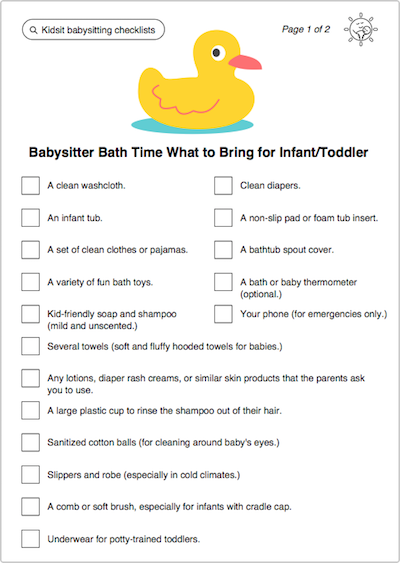
Download Our Bath Time Checklist
We've created a handy bath time checklist that you can print and keep a copy in your babysitting binder. It includes:
- A checklist of what to get ready before a bath
- Genius tips to encourage kids to get into the bath
- Common bath time fears to look out for
(babysitting-bath-time-checklist-v3.pdf 58kb)
Also, see our other babysitting checklists.
Having trouble getting kids into the bath? Read our guide: How to get Kids Into the Bath (10 Genius Tips + Common Bath Time Fears).
Conclusion
Bath time comes with some additional hazards to look out for on top of your usual babysitting risks. It's essential to always be extra vigilant around water. It only takes a second for a child to slip below the surface. And young kids are more sensitive to being burned or scalded by hot water.
Bath time will be a bit different depending on the age of the child you're babysitting. But, no matter what age they are, you'll want to make bath time as fun and engaging as possible! Use toys and games to keep kids busy and happy, and they might not even pay attention to you washing them. Use special shampoos and soaps that are formulated for kids to keep their skin healthy and avoid tears if the products get in their eyes.
Bathing kids might be one of the more intimidating tasks you'll face as a babysitter. But now that you're armed with the tips and information above, you should be able to handle anything that bath time throws at you!
